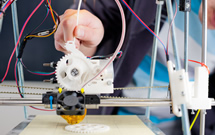Engineering’s place in science standards leaves room for teacher education
 After two years, the final Next Generation Science Standards arrived in April, and along with a focus on rigor and real-world application, the standards include a focus on engineering—and education leaders are ensuring that their teachers have the resources to teach the subject.
After two years, the final Next Generation Science Standards arrived in April, and along with a focus on rigor and real-world application, the standards include a focus on engineering—and education leaders are ensuring that their teachers have the resources to teach the subject.
Historically, many engineering education advocates have said they felt that engineering is the “forgotten E” in STEM. And while many are lauding the renewed focus on engineering, others wonder if classroom teachers have the experience required to teach engineering.
Now, programs are popping up to help educators learn how to teach engineering, and how to identify engineering concepts in topics they already teach. The Parkway School District in St. Louis received a $1.5 million Mathematics and Science Partnership grant for the Scientists in Residence (SIR) program throughout the district.
The SIR Program provides in-depth professional development, coaching, and guidance for the district’s third, fourth, and fifth grade science teachers.
Becky Litherland, K-12 science coordinator in the Parkway School District, said there are a growing number of resources that can help K-12 teachers address important engineering concepts in science and math education. The Boston Museum’s Engineering is Elementary, NSTA resources, and Project Lead The Way all offer engineering resources for classroom teachers.
“Teachers learned content, instructional strategies, but they also learned [engineering], they taught it, so it really increased their level of learning and being able to apply it,” Litherland said.
While SIR’s funding ceased at the end of September, “we’re hoping that we’ve empowered these teachers with their confidence and ideas, and that these things can actually start happening in their classrooms,” she added. Students who participated said learning some of the concepts was “better than video games.”
K-12 science teachers are not always prepared to teach engineering, said Carol Ross-Baumann, the SIR project director.
(Do teachers in your school have engineering skills? Take the poll on Page 2. Plus: Do teachers recognize engineering?)“However, there are a lot of pieces already in the elementary curriculum that involve engineering, but the teachers don’t recognize it as engineering,” she said, such as an electricity unit or a unit on motion and design.
[poll id=”32″]
“Teachers just aren’t trained to recognize engineering—we’re trying to help them recognize it,” she said. “Many units have a natural progression towards engineering, but teachers end the unit too soon and don’t do the engineering. What could be the next step? It’s all about applying those concepts.”
Teacher experiments ranged from a robotics unit, which Ross-Baumann said received a lot of initial push-back until they embraced the concepts and saw how engaged students were, to using Vernier GoTemp sensors to monitor raw potatoes’ temperatures.
A hallmark of the voluntary, internationally-benchmarked standards involves the blending of core science knowledge with scientific practices in an attempt to engage students at a deeper level and help them connect their classroom lessons with relevant, real-world scientific application.
“Engineering is a natural progression from inquiry-based learning,” said Jennifer Proffitt, district high school STEM curriculum coordinator. “I think we blew the teachers’ minds from the first day.”
One of the hardest parts of engineering instruction, Proffitt added, is that teachers must relinquish some control.
“They move from being the deliverer of knowledge to being a facilitator of activity, and for some of them, that’s a big learning process—it’s OK for them to not have every answer. It’s as much about learning different ways to be a teacher as it is about the engineering content.”
- FETC 2025: Good to Know Before You Go - December 12, 2024
- FETC 2025: AI Sessions You’ll Love - December 12, 2024
- A look at one school’s innovative approach to PD - December 11, 2024


Comments are closed.